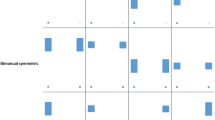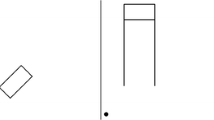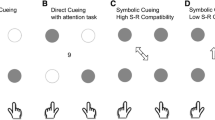Abstract
We examined the movement trajectories of symmetric and asymmetric bimanual reaches to targets specified by direct spatial cues and by indirect symbolic cues. Symbolically cued asymmetric reaches have been shown to exhibit longer reaction times compared with symmetric reaches, whereas no such reaction time cost is observed when targets are spatially cued—a pattern thought to implicate increased demands on response selection (Diedrichsen et al. in Psychol Sci 12(6):493–498, 2001). As symbolically cued reaches impose greater demands on cognitive visuomotor translation than spatially cued reaches (Diedrichsen et al. in Cereb Cortex 16(12):1729–1738, 2006), we asked whether bimanual movements exhibit more spatial coupling with symbolic cues than with spatial cues. Participants made bimanual symmetric and asymmetric reaches to short- and long-distance targets cued either symbolically or spatially. We replicated the reaction time cost for symbolically cued asymmetric movements. A subset of these asymmetric reaches also showed large trajectory modulations. It appeared that this subset had been incorrectly prepared and the movements required of the left and right arms had been switched. No such errors in target selection were observed when targets were spatially cued. In contrast to the reaction time cost and errors in selection for symbolically cued movements, we observed little evidence of increased spatial coupling with symbolic cues when movements were initiated towards the correct targets. We conclude that cognitive visuomotor translation demands during response selection increases bimanual coupling at the level of response selection (reaction time cost, errors in target selection) but not at the level of movement execution (spatial coupling).





Similar content being viewed by others
Notes
We would like to thank an anonymous reviewer for suggesting this analysis.
References
Diedrichsen J, Hazeltine E, Kennerley S, Ivry RB (2001) Moving to directly cued locations abolishes spatial interference during bimanual actions. Psychol Sci 12(6):493–498
Diedrichsen J, Ivry RB, Hazeltine E, Kennerley S, Cohen A (2003) Bimanual interference associated with the selection of target locations. J Exp Psychol Hum Percept Perform 29(1):64–77
Diedrichsen J, Nambisan R, Kennerley SW, Ivry RB (2004) Independent on-line control of the two hands during bimanual reaching. Eur J Neurosci 19(6):1643–1652
Diedrichsen J, Grafton S, Albert N, Hazeltine E, Ivry RB (2006) Goal-selection and movement-related conflict during bimanual reaching movements. Cereb Cortex 16(12):1729–1738
Fitts PM (1954) The information capacity of the human motor system in controlling the amplitude of movement. J Exp Psychol 47(6):381–391
Fitts PM, Peterson JR (1964) Information capacity of discrete motor responses. J Exp Psychol 67(2):103–112
Franz EA (1997) Spatial coupling in the coordination of complex actions. Q J Exp Psychol A 50(3):684–704
Franz EA, Zelaznik HN, McCabe G (1991) Spatial topological constraints in a bimanual task. Acta Psychol 77(2):137–151
Franz EA, Eliassen J, Ivry RB, Gazzaniga MS (1996) Dissociation of spatial and temporal coupling in the bimanual movements of callosotomy patients. Psychol Sci 7(5):306–310
Franz EA, Zelaznik HN, Swinnen SP, Walter C (2001) Spatial conceptual influences on the coordination of bimanual actions: when a dual task becomes a single task. J Mot Behav 33(1):103–112
Hazeltine E, Diedrichsen J, Kennerley SW, Ivry RB (2003) Bimanual cross-talk during reaching movements is primarily related to response selection, not the specification of motor parameters. Psychol Res 67(1):56–70
Heuer H, Klein W (2005) Intermanual interactions in discrete and periodic bimanual movements with same and different amplitudes. Exp Brain Res 167(2):220–237
Heuer H, Klein W (2006) The influence of movement cues on intermanual interactions. Psychol Res 70(4):229–244
Heuer H, Spijkers W, Kleinsorge T, Steglich C (2001) Static and phasic cross-talk effects in discrete bimanual reversal movements. J Mot Behav 33(1):67–85
Ivry R, Diedrichsen J, Spencer R, Hazeltine E, Semjen A (2004) A cognitive neuroscience perspective on bimanual coordination and interference. In: Swinnen SP, Duysens J (eds) Neuro-beahvioral determinants of interlimb coordination: a multidisciplinary approach. Kluwer Academic Publishers, Norwell, Massachusetts, pp 259–295
Kelso JA, Southard DL, Goodman D (1979) On the coordination of two-handed movements. J Exp Psychol 5(2):229–238
Kelso JA, Putnam CA, Goodman D (1983) On the space-time structure of human interlimb co-ordination. Q J Exp Psychol A 35(2):347–375
Khan MA, Franks IM, Elliot D, Lawrence GP, Chua R, Bernier PM, Hansen S, Weeks DJ (2006) Inferring online and offline processing of visual feedback in target-directed movements from kinematic data. Neurosci Biobehav Rev 30(8):1106–1121
Luce RD (1986) Response times: their role in inferring elementary mental organization. Oxford University Press, New York
Marteniuk RG, MacKenzie CL, Baba DM (1984) Bimanual movement control: information processing and interaction effects. Q J Exp Psychol A 36(2):335–365
Oliveira FT, Ivry RB (2008) The representation of action: insights from bimanual coordination. Curr Dir Psychol Sci 17(2):130–135
Picard N, Strick PL (2001) Imaging the premotor areas. Curr Opin Neurobiol 11(6):663–672
Rosenbaum DA, Dawson AM, Challis JH (2006) Haptic tracking permits bimanual independence. J Exp Psychol Hum Percept Perform 32(5):1266–1275
Sherwood DE (1994a) Hand preference, practice order, and spatial assimilation in rapid bimanual movement. J Mot Behav 26(2):123–134
Sherwood DE (1994b) Interlimb amplitude differences, spatial assimilations, and the temporal structure of rapid bimanual movements. Hum Mov Sci 13(6):841–860
Spijkers W, Heuer H (1995) Structural constraints on the performance of symmetrical bimanual movements with different amplitudes. Q J Exp Psychol 48(3):716–740
Spijkers W, Heuer H, Kleinsorge T, van der Loo H (1997) Preparation of bimanual movements with same and different amplitudes: Specification interference as revealed by reaction time. Acta Psychol 96(3):207–227
Swinnen SP, Wenderoth N (2004) Two hands, one brain: cognitive neuroscience of bimanual skill. Trends Cogn Sci 8(1):18–25
Swinnen SP, Walter CB, Shapiro DC (1990) The coordination of limb movements with different kinematic patterns. Brain Cogn 8(3):326–347
Swinnen SP, Lee TD, Verschueren S, Serrien DJ, Bogaerds H (1997) Interlimb coordination: learning and transfer under different feedback conditions. Hum Mov Sci 16(6):749–785
Wadman N, Denier van der Gon JJ, Geuze RH, Mol CR (1979) Control of fast goal-directed arm movements. J Hum Mov Stud 5(1):3–17
Wenderoth N, Weigelt M (2009) Visual cues influence motor coordination: behavioral results and potential neural mechanisms mediating perception-action coupling and response selection. Prog Brain Res 174:179–188
Wenderoth N, Van Dooren M, Vanderbroek A, De Vos J, Vangheluwe S, Stiner CM, Byblow WD, Swinnen SP (2009) Conceptual binding: integrated visual cues reduce processing costs in bimanual movements. J Neurophysiol 102(1):302–311
Zelaznik HZ, Hawkins B, Kisselburgh L (1983) Rapid visual feedback processing in single-aiming movements. J Mot Behav 15(3):217–236
Acknowledgments
We would like to thank two anonymous reviewers for their insightful critiques. This research was supported by a Natural Sciences and Engineering Research Council of Canada (NSERC) Discovery grant awarded to RC. JB was supported by an NSERC scholarship.
Author information
Authors and Affiliations
Corresponding author
Rights and permissions
About this article
Cite this article
Blinch, J., Cameron, B.D., Franks, I.M. et al. Bimanual reaches with symbolic cues exhibit errors in target selection. Exp Brain Res 212, 541–554 (2011). https://doi.org/10.1007/s00221-011-2762-4
Received:
Accepted:
Published:
Issue Date:
DOI: https://doi.org/10.1007/s00221-011-2762-4




